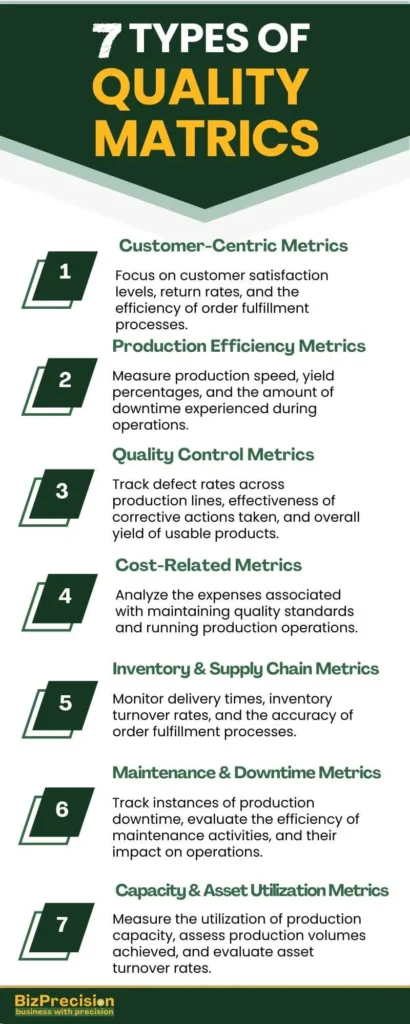25 Essential Quality Metrics to Track
Are you ready to take your business to the next level? Track key quality metrics to grow your business and improve performance. Quality metrics help companies to perform better and satisfy customers.
Monitoring quality metrics is crucial for effective quality assurance and quality control. By understanding these metrics, businesses can implement both QA and QC strategies effectively.
Importance of Tracking Quality Metrics
Tracking quality metrics is very important. They guide businesses to keep improving. By regularly measuring and analyzing these quality metrics for business, you can:
- Identify trends and patterns: Track changes over time to spot where quality is getting worse or better.
- Benchmark performance: Measure your metrics against industry standards or your goals.
- Make data-driven decisions: Use metric insights to guide your strategies and resource allocation.
- Boost customer satisfaction: Good products and services make customers happy and loyal.
- Reduce costs: Better quality means fewer defects and less waste, reducing production and operation costs.

Types of Metrics Covered
This article categorizes quality metrics into several key areas:
Customer-Centric Metrics: Focus on customer satisfaction, returns, and order fulfillment.
Production Efficiency Metrics: Measure production speed, yield, and downtime.
Quality Control Metrics: Track defect rates, corrective actions, and yield.
Cost-Related Metrics: Analyze costs associated with quality and production.
Inventory and Supply Chain Metrics: Monitor delivery times, inventory turnover, and order fulfillment.
Maintenance and Downtime Metrics: Track production downtime and maintenance effectiveness.
Capacity and Asset Utilization Metrics: Measure capacity utilization, production volume, and asset turnover.
Customer-Centric Metrics
Customer satisfaction metrics show how well a company meets customer expectations. High satisfaction brings customer loyalty, repeat business, and positive word-of-mouth.
Methods to Measure Customer Satisfaction:
- Customer satisfaction surveys: Use surveys, email questionnaires, or online forms to gather feedback.
- Customer service metrics: Track resolution time, first contact resolution rate, and customer sentiment from calls.
- Net Promoter Score (NPS): NPS measures how likely customers are to recommend the company.
Customer Rejects:
High return rates can hurt a business’s ROI. They cause lost revenue, extra processing costs, and hurt brand reputation.
Strategies to Minimize Customer Rejections:
- Apply rigorous quality control measures: Ensure products meet quality standards before reaching customers.
- Gather customer feedback: Use feedback from returns to find and fix recurring issues.
- Offer clear and transparent return policies: Make return procedures and timelines clear and easy to understand.
Rate of Return
Return rate analysis calculates the number of returned items divided by the total number of items sold. It helps businesses identify areas for improvement.
Ways to Reduce Return Rate:
- Improve product quality: Prevent defects and ensure products meet customer expectations.
- Accurate product descriptions and specifications: Give customers clear information about what they are buying.
- Offer excellent customer service: Quickly address customer concerns to reduce dissatisfaction.
Perfect Order Performance (POP)
POP measures the percentage of perfect orders, including on-time and accurate delivery.
KPIs for POP include:
- On-time delivery rate: Percentage of orders delivered on time.
- Fill rate: Percentage of ordered items included in the delivered shipment.
- Error-free rate: Percentage of orders delivered without any quantity, product type, or billing errors.
Achieving Perfect Orders:
- Streamline order fulfillment processes: Use efficient systems to reduce errors and delays.
- Maintain accurate inventory records: Keep real-time inventory data to avoid stockouts and wrong shipments.
- Strengthen communication with suppliers: Work with suppliers for timely and accurate deliveries.
Production Efficiency Metrics
Production efficiency metrics show how well resources are used in manufacturing, a topic further explored in our Material Management Process. These metrics help find bottlenecks, improve processes, and boost productivity, leading to higher output and lower costs.
Overall Equipment Effectiveness (OEE)
OEE measures how effective production equipment is, considering three factors: availability, performance, and quality.
Components of OEE:
OEE measures the effectiveness of production equipment, considering three factors:
- Availability: Percentage of time equipment is available for production.
- Performance: The actual production rate compared to the maximum possible rate.
- Quality: Percentage of units produced without defects.
Improving OEE:
- Apply preventive maintenance: Schedule regular maintenance to prevent equipment breakdowns.
- Improve production processes: Improve processes to reduce waste and use equipment better.
- Invest in quality control measures: Reduce defects and improve overall production quality.
First Pass Yield (FPY)
First-pass yield (FPY) metrics measure the percentage of units produced correctly the first time without rework or scrap. High FPY indicates efficient production processes and minimizes production quality issues.
Techniques to Improve FPY:
- Apply strong quality control procedures: Inspect raw materials and components before production to prevent defects.
- Standardized work instructions: Ensure all employees follow clear and consistent procedures.
- Provide proper training: Train employees on quality standards and best practices for production processes.
Cycle Time
Cycle time, or production lead time, measures the total time to complete a production unit.
Reducing Cycle Time for Efficiency:
- Identify and eliminate bottlenecks: Analyze processes to find and fix delays.
- Improve communication and collaboration: Improve communication between departments to avoid delays.
- Invest in automation: Mechanize repetitive tasks to boost speed and efficiency.
Throughput
Throughput is the average number of units produced per time unit. Optimizing throughput increases production output and overall efficiency.
Enhancing Production Throughput:
- Improve production scheduling: Plan schedules well to reduce idle time and use equipment better.
- Reduce setup times: Use quick-changeover procedures to minimize the time between production runs.
- Improve equipment reliability: Keep equipment well-maintained and working well.
Efficiency
Assessing production efficiency measures the number of finished products made compared to the resources used. It shows how healthy resources are optimized.
It’s a crucial indicator of resource optimization.
Strategies for Improvement:
- Minimize waste and rework: Carry out lean manufacturing to cut waste and rework, using resources better.
- Improve inventory management: Maintain optimal inventory to avoid running out or having too much, which causes waste.
- Continuously monitor and improve processes: Regularly analyze production data to find ways to be more efficient.
Quality Control Metrics
These metrics ensure products meet standards and customer expectations. Tracking defect rates and corrective actions helps companies improve quality, cut waste, and boost customer satisfaction.
Quality Metrics:
Quality standards directly measure the quality of products and processes. They help identify and address defects to ensure products meet customer expectations and safety standards.
Ensuring High-Quality Standards:
- Execute a reliable quality management system: Set clear quality standards, procedures, and inspection processes.
- Train employees on quality control: Train all employees on quality expectations and defect identification.
- Conduct regular audits and inspections: Regularly check quality control processes and product quality to find and fix issues.
Defect Density
Defect density refers to the rate of defects per unit of production. It’s a key metric for defect rate analysis and identifying areas with high defect rates.
Reducing Defects in Production:
- Apply statistical process control (SPC): Use SPC techniques to monitor production processes and identify trends that may lead to defects.
- Invest in defect prevention: Focus on improving quality control measures to prevent defects from occurring.
- Analyze defect data: Analyze data from detected defects to identify root causes and apply corrective actions.
Corrective and Preventive Action (CAPA) Effectiveness
CAPA processes are crucial for addressing identified defects and preventing their recurrence. Effective CAPA ensures that corrective actions are implemented promptly and effectively, improving long-term quality.
Ensuring CAPA Effectiveness:
- Clearly define and document CAPA procedures: Establish clear guidelines for identifying, investigating, and resolving defects.
- Track and monitor CAPA performance: Monitor the progress of corrective actions and ensure they are fulfilled effectively.
- Analyze the effectiveness of CAPA actions: Regularly evaluate corrective actions’ effectiveness to ensure they prevent future defects.
Yield
Yield improvement techniques focus on the percentage of suitable units produced compared to the total number of units started in production.
Improving Yield Rates:
- Minimize defects and rework: Apply quality control measures to reduce the number of defective units.
- Maximize production processes: Streamline workflows and eliminate waste.
- Reduce setup times: Minimize the time it takes to switch between different production tasks.
Scrap Rate
Scrap rate reduction can significantly lower production costs by minimizing unusable materials or products.
Reducing Scrap in Manufacturing:
- Improve material handling: Apply procedures to minimize damage and waste during material handling.
- Improve cutting and processing: Use efficient cutting and processing methods to reduce material waste.
- Perform quality control checks: Regularly inspect materials and products throughout production to identify and address issues early.
Cost-Related Metrics
Cost-related metrics analyze the expenses associated with production and quality management. Understanding these costs enables businesses to boost production cost management.
Cost of Quality (CoQ)
Understanding the cost of preventing, identifying, and correcting defects, including scrap, rework, and warranty claims, is crucial for quality cost analysis.
Balancing Quality and Cost:
While high quality is essential, businesses must also strive for cost-effectiveness. Achieving the optimal balance between quality and cost is critical for sustained success.
Production Costs
Production costs encompass all expenses incurred during manufacturing, including the critical components of raw materials, labor, overhead, energy, utilities, and equipment maintenance.
Components of Production Costs:
- Raw materials
- Labor
- Overhead costs
- Energy and utilities
- Equipment maintenance
Reducing Production Expenses:
- Negotiate better prices with suppliers: Seek competitive pricing for raw materials and services.
- Improve production efficiency: Minimize waste and improve processes to reduce labor and overhead costs.
- Invest in energy-efficient equipment: Choose equipment that minimizes energy consumption.
Overall Cost
Understanding the total cost of production, including quality-related costs, is essential for informed decision-making.
Optimizing Cost Efficiency:
- Analyze cost data regularly: Identify areas where costs can be reduced without compromising quality.
- Apply cost-saving initiatives: Explore strategies to reduce production and quality-related costs.
- Focus on continuous improvement: Continuously strive for efficiency improvements across all aspects of the business.
Inventory and Supply Chain Metrics
Quality and inventory metrics track how well inventory and the supply chain are managed. These indicators ensure timely delivery, optimal inventory levels, and improved supply chain performance, leading to customer satisfaction and lower costs.
Delivery Time
Delivery time is the time it takes for a product to reach the customer after an order is placed. Therefore, improving delivery time is crucial for customer satisfaction and meeting delivery deadlines.
- Track average delivery times: Measure how long orders take to be shipped and delivered.
- Identify and address bottlenecks: Analyze the supply chain to identify any areas causing delays and provide solutions.
- Collaborate with suppliers: Ensure timely raw materials and components delivery.
Inventory Turns
Inventory turns measure how often inventory is sold and replaced throughout a specific period. It indicates how efficiently inventory is managed.
- Calculate inventory turnover: To find the cost of goods sold, divide it by the average inventory value for a specified timeframe.
- Higher inventory turns are generally desirable: They indicate efficient inventory management and reduce carrying costs.
Enhancing Inventory Turnover:
- Execute just-in-time (JIT) inventory management: Order materials only when needed to reduce holding costs.
- Improve sales forecasting: Accurate forecasts help plan inventory and prevent overstocking or understocking.
- Reduce lead times: Get raw materials and components faster from suppliers.
Perfect Order Performance
Perfect order performance indicators (POP) are vital for customer satisfaction and quality control. They ensure timely, complete, and error-free orders, reducing returns and rework.
To achieve perfection in orders:
- 1. Streamline order processing: Apply efficient systems and procedures to minimize errors and delays throughout the order fulfillment.
- 2. Strengthen communication and collaboration: Ensure clear and consistent communication between all departments involved in order fulfillment, from sales to production and logistics.
- 3. Invest in technology: Use technology to track orders, manage inventory, and simplify processes.
Maintenance and Downtime Metrics
Production Downtime
Production downtime significantly affects output and revenue. Reducing downtime is vital to maintaining efficiency and preventing revenue loss.
Production downtime refers to any period when production equipment is not operational due to breakdowns, maintenance, or other issues.
Minimizing production downtime is crucial for maintaining efficiency and preventing significant impacts on output and revenue. Carry out effective maintenance reduction strategies.
To carry out effective maintenance reduction strategies:
- 1. Apply preventive maintenance: Regularly schedule maintenance to prevent equipment breakdowns and minimize unplanned downtime.
- 2. Invest in reliable equipment: Choose high-quality equipment with a proven track record of reliability.
- 3. Monitor equipment performance: Track key equipment performance indicators (KPIs) to identify potential issues early and address them proactively.
Maintenance Reduction
Effective maintenance reduction strategies minimize downtime and ensure equipment operates at peak performance, aiding production efficiency assessment.
To develop a comprehensive maintenance plan:
- Develop a schedule: Define maintenance schedules, procedures, and responsibilities for all equipment.
- Train maintenance personnel: Ensure technicians are adequately trained and equipped to handle repairs and preventive maintenance tasks.
- Track maintenance costs and effectiveness: Monitor maintenance expenses and the impact of maintenance activities on equipment performance and downtime.
Reducing Maintenance-Related Downtime:
- 1. Perform condition-based monitoring: Use sensors and monitoring systems to track equipment health and predict potential issues before they lead to breakdowns.
- 2. Invest in spare parts and components: Having readily available spare parts minimizes downtime when repairs are needed.
- 3. Analyze maintenance data: Analyze data from maintenance activities to identify areas for improvement and improve maintenance strategies.
Capacity and Asset Utilization Metrics
Capacity utilization metrics and asset turnover improvement measure how well a company uses its production capacity and assets.
By optimizing these metrics, businesses can increase production output, minimize idle time, and ensure that resources are used effectively, improving operational efficiency.
Measuring Capacity Utilization:
Capacity utilization measures the percentage of a company’s production capacity that is actually being used. It’s a key indicator of how efficiently resources are being employed.
- Calculate capacity utilization: Divide actual production output by the maximum possible output based on available resources.
- Higher capacity utilization is generally desirable: It indicates efficient resource utilization and minimizes idle time.
To enhance capacity use:
- Improve production planning and scheduling: Schedule production runs effectively to maximize equipment utilization and avoid bottlenecks.
- Invest in flexible manufacturing systems: Use systems that can adapt to changing production demands and minimize idle time during changeovers.
- Monitor and analyze capacity utilization data: Regularly track and analyze capacity utilization data to identify areas for improvement and amend resource allocation.
Production Volume
Production volume refers to the total amount of product units produced over a specific period. It’s a key metric for measuring production output and assessing the overall performance of the production process.
To enhance production output:
- 1. Improve production processes: Streamline processes to reduce waste and increase output.
- 2. Reduce setup times and changeovers: Streamline processes to reduce waste and increase output.
- 3. Invest in automation and technology: Use automation and technology to boost production efficiency and output.
Asset Turnover
The asset turnover ratio shows how efficiently a company uses its fixed assets, such as equipment. It indicates the amount of revenue generated per unit of invested assets.
To calculate asset turnover, divide the total revenue by the average value of fixed assets over a specific period.
Higher asset turnover is good. It shows efficient asset use and maximizes return on investment.
To improve asset utilization:
- 1. Refine asset allocation: Ensure assets are used for their intended purpose and allocated to areas where they can generate the most value.
- 2. Invest in asset maintenance and upgrades: Regular maintenance and upgrades extend asset life and boost efficiency.
- 3. Monitor and analyze asset utilization data: Regularly track and study asset data to find underutilized assets and improvement opportunities.
Conclusion
This article has covered 25 key quality metrics, explaining their importance and how to track them effectively. Monitoring these metrics helps companies understand their performance, find improvement areas, and deliver high-quality products and services.
Final Thoughts on Implementing and Tracking Metrics:
Implementing and tracking quality metrics needs commitment from all levels of your organization. Continuous improvement in quality metrics is vital. Imagine your whole team working together, each member knowing their role in maintaining high standards. It’s critical to:
- 1. Clearly define and communicate quality goals: Set clear standards and ensure everyone knows their role in achieving them.
- 2. Select the right metrics: Choose relevant metrics that provide valuable insights for improvement.
- 3. Invest in data collection and analysis tools: Use the right tools to collect, track, and analyze quality data.
- 4 Regularly review and analyze data: Make data analysis a habit to identify trends, measure progress, and make informed decisions.
Tracking quality metrics is continuous, not a one-time event. Companies can continuously monitor data to find improvement opportunities, take corrective actions, and aim for excellence.
Remember, committing to quality is a journey, not a destination.







